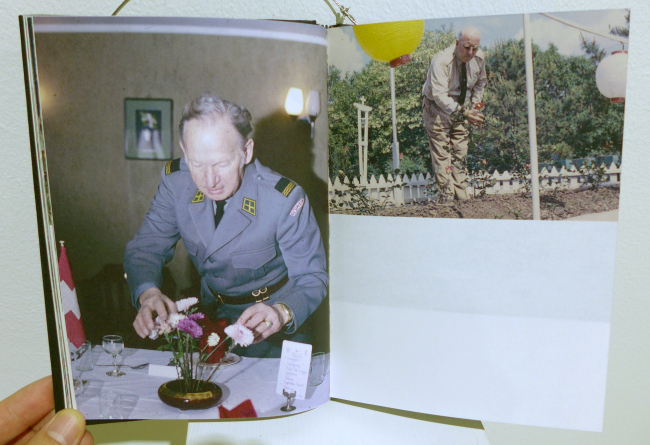The Demilitarized Zone, a 4-kilometer-wide strip of virgin greenery cutting through the heart of the Korean Peninsula, provided sources of artistic inspiration for a group of international artists based in Geneva, Switzerland.
“Territories of Assembly,” an exhibition comprised of photography, film, audio and installation art related to the DMZ, is being held at Art Sonje Center in northern Seoul from Oct. 18 to Nov. 2, sponsored by the Swiss Embassy in Korea.
Seven artists ― Swiss, French, Belgian and Korean ― from Haute Ecole d’Art et de Design conducted a study in the no man’s land in 2013, exploring some heavy geopolitical issues as well as the wildlife and flora that thrive in one of the most heavily militarized borders in the world.
Denise Bertschi, 31, from Aarau in Switzerland, decided to question the role of “neutrality” in a hostile military environment through her work. When she dug into a military archive in Berne, she discovered a collection of photographs showing Swiss soldiers stationed in the Joint Security Area on a Neutral Nations Supervisory Commission mission.
“I was intrigued by how these Swiss soldiers were engaged in banal, everyday activities on the cusp of the Cold War,” Bertschi said. “They created a ‘Little Switzerland’ in these marshaled woodlands.”
Switzerland confirmed its “bold commitment” to the NNSC ― the product of the 1953 Armistice Agreement which ended the Korean War, and which sought to regulate relations between the Communist North and Democratic South. Some newspapers wrote then, “The Swiss government considers it a moral duty toward the international community and the Korean people to take part in the ‘adventurous undertaking in East Asia,’” according to one Swiss Embassy publication.
 |
Swiss soldiers stationed in the Joint Security Area of the DMZ engaged in everyday, “peace-making” activities as shown in Denise Bertschi’s photo collection. (Joel Lee/The Korea Herald) |
The first 100 or so Swiss military personnel set foot in Panmunjeom on the 38th Parallel in July 1953 to fulfill their “delicate diplomatic mandate” along with delegates from Sweden, Poland, Czechoslovakia and India. Currently there are five Swiss and five Swedish representatives stationed in the JSA.
In Bertschi’s photo collection, Swiss soldiers wearing tuxedos and bow ties celebrate their holidays on foreign soil with Christmas trees and candlelight. Some carefully water the plants and flowers while basking in the sun. The interior of the barracks resembles a Swiss lakeside cottage.
“Neutrality is a fact of everyday life in Switzerland,” the first secretary of the Swiss Embassy Doris Walchli Giraud told The Korea Herald. Giraud said that after centuries of territorial invasions, her country charted a course of its own to become a neutral sovereign nation 150 years ago. The host of the first Geneva Convention, Switzerland abstained from taking a role in armed conflicts and was spared the carnage of the two world wars.
“Art (works) can have a more powerful impact than government, because they create living exchanges between people,” she said. “They fill the dialogue.”
Contemporary art occupies a prominent position in Switzerland’s cultural landscape, with the national arts council Pro Helvetia funded entirely by the federal government. The state support for art is institutionalized on three levels: federal, cantonal (provincial) and municipal.
The philosophy of rationality and practicality define Swiss art as “concrete” rather than “abstract,” adding to its vogue and allure around the world.
The Swiss Embassy in Korea is holding the “Innovations Forum” at Seoul National University’s Museum of Art on Nov. 8 and 15, celebrating innovation through the convergence of art, science and society. For more information, visit www.digitalartweeks.ethz.ch or call (02) 880-9504.
By Joel Lee (
joel@heraldcorp.com)








